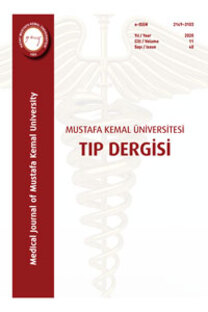Çocuk nöroloji kliniğine senkop şikayeti ile başvuran hastaların retrospektif özellikleri
Retrospective characteristics of patients presenting to the pediatric neurology clinic with syncope
___
- Feit LR. Syncope in the pediatric patient: diagnosis, pathophysiology, and treatment. Adv Pediatr 1996;43: 469–94.
- Friedman NR, Ghosh D, Moodley M. Syncope and paroxysmal disorders other than epilepsy. Swaiman’s Textbook of Pediatric Neurology, China; Elsevier, Inc, 2012; 905-925.
- Bo I, Carano N, Agnetti A, Tchana B, Allegri V, Sommi M, Squarcia U. Syncope in children and adolescents: a two- year experience at the Department of Paediatrics in Parma. Acta Biomed 2009;80: 36–41.
- Massin MM, Bourguignont A, Coremans C, Comte L, Lepage P, Gerard P. Syncope in pediatric patients presenting to an emergency department. J Pediatr 2004;145: 223–228. https://doi.org/10.1016/j.jpeds.2004.01.048
- Kanjwal K, Calkins H. Syncope in children and adolescents. Cardiac Electrophysiol Clin 2013;5: 443–455. https://doi.org/10.1016/j.ccl.2015.04.008
- Driscoll DJ, Jacobsen SJ, Porter CJ, Wollan PC. Syncope in children and adolescents. J Am Coll Cardiol 1997;29: 1039–45. https://doi.org/10.1016/s0735-1097(97)00020-x
- Kaufman H. Evaluation of the patient with syncope. In: Robertons D, Biaggioni I, Burnstock G, editors. Primer on the autonomic nervous system. 2nd ed. San Diego: Elsevier Academic Press; 2004.
- Crompton DE, Berkovic SF. The borderland of epilepsy: clinical and molecular features of phenomena that mimic epileptic seizures. Lancet Neurol 2009;8: 370–381. https://doi.org/10.1016/S1474-4422(09)70059-6
- Uysal F, Bostan ÖM, Çetinkaya F, Deniz T, Çil E. Syncope in Children: Is Rhythm Holter Monitoring Necessary?. J Curr Pediatr 2016;14: 124-128. https://doi.org/10.4274/jcp.32932
- Öztoprak Ü. Etiology and Neuruological Evaluation of Non-Cardiogenic Syncope in Children. Pediatric Practice and Research. 2019;7(Ek): 111-115.
- Bozlu G, Durak F, Duman D, Karpuz D, Kömür M, Haliloğlu O. Çocuk Acil Servise Senkop Nedeniyle Getirilen 1020 Olgunun Geriye Dönük Değerlendirilmesi. Mersin Üniversitesi Sağlık Bilimleri Dergisi 2020;13(1): 8-12. https://doi.org/10.26559/mersinsbd.631787
- Yılmaz Ü, Özdemir R, Katipoğlu N, Dağ T, Berksoy EA, Timur M. Çocuklarda Senkop Etiyolojisi, Nörolojik ve Kardiyolojik İncelemelerin Tanıdaki Değeri. Türkiye Çocuk Hastalıkları Dergisi 2014;8(2): 64-70. https://doi.org/10.12956/tjpd.2014.50
- Viswanath D, Prabhuji MLV, Menon VV, Kailasam S, Kumar M. Syncope in children. J Indian Acad Oral Med Radiol 2013;25: 294-299.
- Chen L, Zhang Q, Ingrid S, Chen J, Qin J, Du J. Aetiologic and clinical characteristics of syncope in Chinese children. Acta Paediatrica 2007;96(10):1505-1510.
- Mohanty S, Kumar CPR, Kaku SM. Clinico-Etiological Profile of Pediatric Syncope: A Single Center Experience. Indian Pediatr 2021 Feb 15;58(2): 134-137.
- Zavala R, Metais B, Tuckfield L, DelVecchio M, Aronoff S. Pediatric Syncope: A Systematic Review. Pediatr Emerg Care 2020 Sep;36(9): 442-445.
- Hurst D, Hirsh DA, Oster ME, Ehrlich A, Campbell R, Mahle W T, et al. Syncope in the pediatric emergency department–Can we predict cardiac disease based on history alone?. The Journal of Emergency Medicine 2015;49(1): 1-7.
- Massin MM, Bourguignont A, Coremans C, Comte L, Lepage P, Gerard P. Syncope in pediatric patients presenting to an emergency department. J Pediatr 2004;145:223–228.
- Kanjwal K, Calkins H. Syncope in children and adolescents. Cardiac Electrophysiol Clin 2013;5:443–55.
- Driscoll DJ, Jacobsen SJ, Porter CJ, Wollan PC. Syncope in children and adolescents. J Am Coll Cardiol 1997;29: 1039–45.
- ISSN: 2149-3103
- Yayın Aralığı: Yılda 3 Sayı
- Başlangıç: 2010
- Yayıncı: Hatay Mustafa Kemal Üniversitesi Tıp Fakültesi Dekanlığı
Gülsüm KAYA, Şeyma TRABZON, Selma ALTINDİŞ, Ruveyda ALACAHAN
Fatmanur TUNCEL, Nuri Cenk COŞKUN
COVID-19 pandemisi döneminde onkolojik ve acil cerrahi vakalarının yönetimi
Mehmet Burak DAL, Mustafa UĞUR, Mehmet Esat DUYMUŞ, Muhyittin TEMİZ
Mehmet CANİKLİOĞLU, Volkan SELMİ, Sercan SARI, Ünal ÖZTEKİN, Muharrem ÖZKAYA, Levent IŞIKAY
Dilara AKÇORA YILDIZ, Yakuphan BAYKAN, Fadime AŞIK
Çocuk nöroloji kliniğine senkop şikayeti ile başvuran hastaların retrospektif özellikleri
Hilal AYDIN, İbrahim Hakan BUCAK, Sümeyye ERDOĞAN
Neslihan GÜNEY, İclal GÜRSES, Ebru SERİNSÖZ LİNKE, Didar GÜRSOY, Enver ÜÇBİLEK, Tahsin ÇOLAK
Filiz KAÇMAZ, Oğuzhan ÖZCAN, Abdullah ARPACI, Ercan AYAZ, Hamdullah Suphi BAYRAKTAR, Sadık GÖRÜR
Yenidoğan Yoğun Bakımda İzlenen Pnömotorakslı Olguların Değerlendirilmesi
